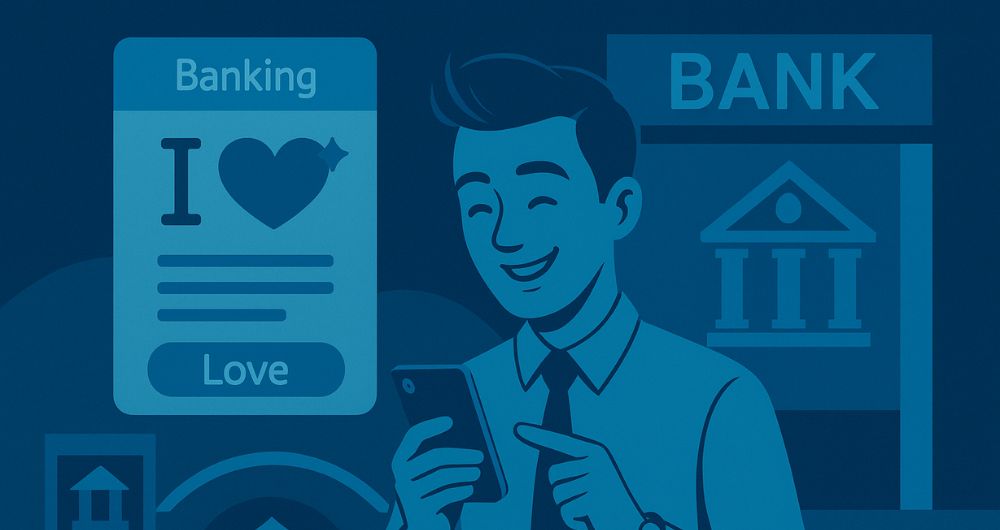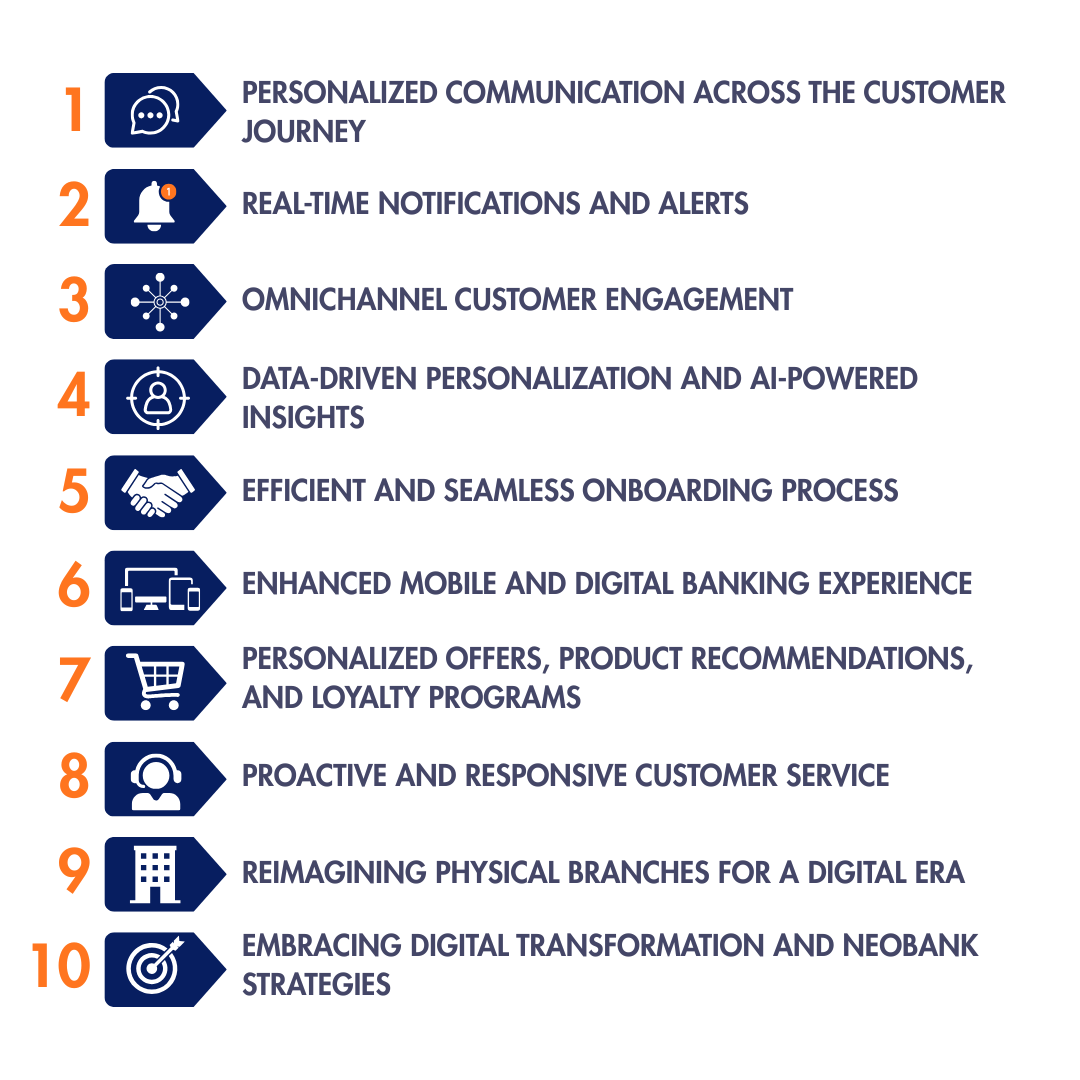
Customer satisfaction isn’t just a buzzword in the banking industry—it’s the difference between a loyal customer base and one quick to jump ship to a competitor. With more options than ever, especially with the rise of digital-first banks and fintechs, customers expect more from their financial institutions. They want personalized service, seamless experiences across all channels, and the reassurance that their bank truly understands their needs.
So, how do the most successful banks rise to the challenge? It’s not just about having the latest technology or the most convenient app. It’s about strategically enhancing every touchpoint in the customer journey, from the first interaction to ongoing support.
To help banks meet these expectations, we have selected 10 of the best strategies that top banks use to boost customer satisfaction:

These strategies are practical, proven, and, when implemented effectively, can make a significant difference in how customers perceive and interact with your bank. With the right technology partner, like Latinia, these strategies are not just aspirational—they’re achievable.
The Top 10 Strategies to Boost Customer Satisfaction in Banking
To truly excel in customer satisfaction, top banks focus on a combination of personalized service, cutting-edge technology, and seamless integration across channels. These strategies are about responding to customer needs and anticipating them, ensuring every interaction leaves a positive impression.
By adopting these best practices, banks can foster deeper connections with their customers, build trust, and create a more loyal customer base.
1. Personalized Communication Across the Customer Journey
Personalized communication is essential for boosting customer satisfaction in banking. Leading banks tailor their interactions to each customer’s specific needs and preferences.
- For example, a bank might notice a customer’s frequent travel and proactively offer travel insurance or favorable currency exchange rates. This kind of personalization shows that the bank understands and values the customer.
The impact on ROI
91 percent of consumers are more likely to engage with brands that offer relevant recommendations. Accenture
Personalization can increase marketing ROI by five to eight times . McKinsey
How Latinia enhances this strategy
Moreover, communicating with customers according to their preferences is crucial. Latinia’s Subscription Engine allows banks to manage and deliver personalized communications through the customer’s preferred channels, enhancing the overall experience.
Additionally, Latinia’s Next Best Action (NBA) capabilities ensure that the most relevant messages are sent at the right moments throughout the customer journey, further strengthening customer satisfaction and loyalty.
2. Real-Time Notifications and Alerts
Real-time notifications are crucial for enhancing customer satisfaction in banking. In today’s digital world, customers expect instant updates about their accounts and transactions, which can significantly reduce anxiety and build trust. Top banks are using real-time alerts not just for online interactions but also for any real-time transactions, ensuring that customers are always in the loop.

EXPERT TIP
The value does not lie in a post mortem analysis of what a customer did yesterday, it lies in deciding within milliseconds while the customer is acting in that very moment. Stop accumulating data and focus on an architecture that allows you to act on it in real time.
- For example, if a large purchase is made or suspicious activity is detected, an immediate alert reassures customers that their bank is actively monitoring their accounts. This proactive communication is essential for fostering a sense of security and reliability.
The impact on customer satisfaction
Research shows that improving digital engagement, including through real-time alerts, directly correlates with higher customer satisfaction. According to McKinsey, banks that effectively engage customers through digital channels significantly increase satisfaction levels, which also drives customer loyalty and trust.
This focus on timely and relevant communication is essential for any bank looking to enhance customer satisfaction in a competitive landscape.
How Latinia enhances this strategy
Latinia’s Real-Time Analysis and Decision Engine plays a key role in enabling banks to deliver these timely notifications. By analyzing real-time transaction data, banks can send relevant and immediate alerts, enhancing the customer experience and reinforcing trust.
3. Omnichannel Customer Engagement
Omnichannel customer engagement has become a vital strategy for banks aiming to enhance customer satisfaction. This approach ensures customers can interact with the bank across various channels—such as mobile apps, websites, call centers, or physical branches—while enjoying a consistent and seamless experience. Whether starting a transaction online and completing it in a branch or resolving an issue through multiple touchpoints, customers expect a unified experience.
Why maintaining fluidity between channels is key
Research indicates that banks with effective omnichannel strategies often report higher customer satisfaction and loyalty. Customers appreciate the ability to switch between channels without disruptions, which improves their experience and contributes to a stronger relationship with the bank.
Additionally, omnichannel engagement allows banks to synchronize data across platforms in real time, reducing customers’ need to repeat information. This leads to faster problem resolution and more personalized service, which are crucial for meeting the expectations of today’s tech-savvy customers.
How Latinia enhances this strategy
Latinia supports omnichannel engagement by enabling banks to deliver real-time, personalized communications through digital channels such as SMS, push notifications, and email.
It ensures seamless integration across these channels, allowing banks to maintain consistent and timely customer interactions, enhancing the overall customer experience in a mobile-first environment.
4. Data-Driven Personalization and AI-Powered Insights
Data-driven personalization and AI-powered insights are transforming banking, enabling institutions to offer tailored customer experiences. Banks analyze extensive customer data to understand behaviors, preferences, and financial needs, which helps them recommend products and services that enhance customer satisfaction.
Practical implementation
- For example, AI can evaluate a customer’s spending patterns to suggest investment opportunities or customized financial plans. This approach aligns with customer expectations and builds stronger loyalty, as customers feel understood and valued.
Why personalization is key for the sector
Research highlights that hyper-personalization, driven by AI, is essential for banks to differentiate themselves in a competitive market. It facilitates real-time, relevant interactions across all channels, helping banks establish more profound, more meaningful customer relationships.
5. Efficient and Seamless Onboarding Process
The onboarding process shapes a customer’s first impression of a bank. A smooth and efficient onboarding experience can lead to higher customer satisfaction and long-term loyalty, while a slow, complicated process may drive customers away.
How digitization has changed this process
Digital onboarding tools have transformed the way banks handle this process. These tools allow for rapid identity verification, reduce the need for paperwork, and enable customers to open accounts from anywhere, often in just a few minutes. Many banks now incorporate biometric verification and e-signatures, eliminating the need for physical document submission and in-person visits.
What value does it bring to the bank and the customer?
Banks implementing efficient digital onboarding processes see significant benefits, including higher customer retention and faster account activation.
Customers value the convenience of digital onboarding, especially as the demand for digital banking services continues to grow.
This streamlined experience is a key differentiator in a competitive market, where customers can easily switch to banks offering better digital services.
6. Enhanced Mobile and Digital Banking Experience
Delivering an enhanced mobile and digital banking experience is essential in today’s banking landscape, where customers expect convenience and accessibility at their fingertips. Banks that excel in providing seamless, user-friendly digital platforms can significantly improve customer satisfaction and retention.
What users demand today
Customers now demand more than just basic online banking. They look for comprehensive digital services that allow them to manage their finances easily, make transactions, access personalized financial advice, and even apply for loans—all from their mobile devices. Neobanks and fintech companies have set high standards in this area, pushing traditional banks to innovate and improve their digital offerings to remain competitive.
How it influences customer relations
Banks prioritizing the mobile and digital experience often see increased customer engagement and loyalty.

EXPERT TIP
Features such as real time notifications, AI based financial information and personalized interfaces elevate the digital experience, helping customers interact with their bank in a more intuitive and meaningful way.
Additionally, integrating security features like biometric authentication and advanced encryption reassures customers that their data is safe, further boosting their trust in digital channels.
7. Personalized Offers, Product Recommendations, and Loyalty Programs
Personalized offers, product recommendations, and loyalty programs are essential strategies for banks aiming to enhance customer satisfaction and build long-term loyalty. Banks can use data-driven insights to tailor products and services that meet the unique financial needs of each customer, thereby increasing engagement and satisfaction.
How Latinia’s NBA technology works
An effective way to deliver these personalized services is through the implementation of a Next Best Action (NBA) strategy. Latinia’s NBA technology analyzes customer data in real time to determine the most relevant product, offer, or service to present to customers at any given moment.

- For instance, if a customer frequently shops at a specific retailer, the NBA engine might suggest a co-branded card promotion offering discounts at that store. This not only improves the customer experience but also enhances the relevance of the bank’s offerings.
Reinforcement with loyalty programs
Loyalty programs further reinforce this personalized approach by rewarding customers for their ongoing engagement with the bank. Programs like Bank of America’s ‘Preferred Rewards’ or Citibank’s ‘ThankYou Rewards’ offer tiered benefits that increase as customers deepen their relationship with the bank, providing tangible rewards that resonate with their specific behaviors and preferences.
8. Proactive and Responsive Customer Service
Proactive and responsive customer service is crucial for maintaining high levels of customer satisfaction in banking. Banks that excel in this area often use a combination of advanced technology and personalized support to provide timely, relevant assistance.
How Latinia’s technology enables you to stay ahead of the curve
- For example, using Latinia’s Next Best Action (NBA) technology, a bank can detect when a customer’s account balance is running low. The bank could then proactively offer a temporary overdraft or suggest transferring funds from another account to avoid overdraft fees. This proactive approach helps prevent potential issues and enhances the customer experience by providing solutions before the customer even realizes there’s a problem.

How to strengthen responsiveness
Responsive customer service is equally important. When customers do encounter issues, they expect prompt and effective support. Many leading banks employ AI-powered chatbots to handle routine inquiries instantly, allowing human agents to focus on more complex issues. This dual approach ensures that customers receive quick responses to simple queries while still having access to personalized support when needed.
9. Reimagining Physical Branches for a Digital Era
In the digital age, the role of physical bank branches is evolving. While many customers now prefer online and mobile banking, physical branches still play a critical role, particularly for complex financial services and personalized consultations. However, to remain relevant, branches must be reimagined to complement the digital experience rather than compete with it.
What customers are looking for
Modern bank branches are increasingly transforming into “experience centers” where customers can receive personalized advice, learn about financial products, and engage in activities that are difficult to replicate online.
Additionally, integrating digital tools within branches can enhance the customer experience. Interactive kiosks, for instance, allow customers to explore products or services at their own pace before consulting with a banker. This blend of digital convenience and personal service meets today’s customers’ expectations, who value efficiency and human interaction.
How Latinia enhances this strategy
Latinia’s Next Best Action (NBA) technology can also be utilized in branches to personalize customer interactions:
- For example, when a customer visits a branch, the NBA system could suggest specific financial products or services based on their recent account activity or stated goals, offering a seamless transition from digital to in-person banking.
10. Embracing Digital Transformation and Neobank Strategies
Embracing digital transformation is crucial for traditional banks to stay competitive, especially as neobanks set new standards for customer experience with their seamless, mobile-first services. Digital transformation involves not just adding online banking features but rethinking operations, customer engagement, and value delivery through technologies like AI and blockchain.
What do neobanks offer as a reference
Neobanks excel in personalized financial advice and agile service delivery. Traditional banks can adopt similar strategies, using AI-driven tools to offer customized recommendations and adopting agile methodologies to stay responsive to customer needs. By integrating these approaches, traditional banks can enhance their digital offerings, retain customers, and attract new, tech-savvy clients, ensuring they remain relevant in an increasingly digital world.
Conclusion
Enhancing customer satisfaction in banking requires a multi-faceted approach, combining personalized communication, real-time alerts, omnichannel engagement, and cutting-edge digital strategies. By adopting these best practices, supported by technologies like Latinia’s Next Best Action and real-time analysis tools, banks can meet and exceed customer expectations, driving loyalty and long-term success.
To see how these strategies can transform your bank’s customer experience, we invite you to talk to our experts at Latinia. Let’s explore how we can help you stay ahead in a rapidly evolving market.
Categories: Strategy
